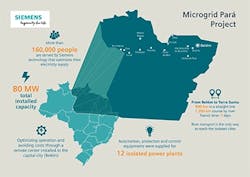Siemens Building an 80-MW Microgrid Network in the Brazilian Amazon
Bringing reliable, secure and affordable electricity to the remote Amazon Basin is probably one of the most difficult obstacles to meeting the UN Sustainable Development Goal of universal electricity access by 2030. But that’s exactly what Siemens Brazil hopes to do by way of a microgrid network.
With the support from Brazilian utility Centrais Elétricas do Pará (CELPA), Siemens Brazil will build, own and operate 12 networked, diesel-fueled microgrids in 12 remote communities across the state of Parà in the Brazilian Amazon. All told, the 80 MW of installed microgrid power capacity will deliver electricity to some 160,000 local residents.
Siemens will design and install 12 microgrids for the Brazilian utility Centrais Elétricas do Pará (CELPA).
Two of the planned 12 community microgrids are already up and running. Siemens Brazil expects to complete the project in its entirety by the end of 2018, Sergio De Oliveira Jacobsen, head of Siemens Brazil’s Digital Grid business unit, told Microgrid Knowledge.
Microgrid network managed via satellite
Using Siemens’ microgrid control and management software, the 12 Parà State community microgrids will be able to operate independently, on a standalone basis. They are also being equipped with satellite communications links to Siemens’ existing central distribution grid operations center in Belém, the state capital.
The satellite communications links will enable Siemens to monitor, control and more efficiently manage and maintain all 12 remote community microgrids, as well as interface with CELPA’s transmission and distribution grid, metering, billing, payment and administration systems, said De Oliveira Jacobsen.
Given the remote location, solving logistical problems is pivotal to success, according to lead project engineer José Ricardo.
“We have a very big challenge with regard to transport. The only way to transport equipment is via rivers that crisscross the state of Pará,” he said. “We have 12 communities – essentially small cities – in isolated areas that don’t have any power supply, and this project is to implement new [microgrid] power plants to supply them with energy.”
In addition to intelligent microgrid and distributed energy resource monitoring, control and management software and communications links, Siemens is supplying the project’s diesel generators. It is also building medium-voltage power distribution lines and connecting them to traditional electricity meters that are being installed in homes and businesses throughout the 12 Pará state communities.
“In each [microgrid] power plant we will have an automation control system to ensure efficient and reliable control of diesel power generation and microgrid operations, including protection relays, electricity meters and database communications locally and to the operations control center in Belèm,” Ricardo said.
Why diesel makes sense
Installing solar photovoltaic (PV) capacity would eliminate the emissions and negative environmental impacts of diesel-fueled power generation, as well as the problems associated with maintaining a constant supply of fuel for power generation across the 12 Amazonian communities. That raises the problem of energy supply intermittency, however, De Oliveira Jacobsen explained.
“We’re just starting to test solar, but given the intermittent nature of solar power generation we would have to have energy storage capacity. Advanced, battery-based energy storage capacity is still very expensive here, and we would need a lot of it given the total 80 MW of power generation capacity,” he said.
Hydroelectric power generation is another alternative, but that too comes with problems. “First, hydro is a big investment. Second, it comes with a big environmental impact, so it’s just not feasible,” De Oliveira Jacobsen said.
To be managed effectively, each local community microgrid power plant will require six or seven employees. Customer billing, payments and communications will all be handled by CELPA.
“We have no direct connection to the consumers. We will simply pass all the necessary microgrid data and information on to CELPA via automated processes,” De Oliveira Jacobsen explained.
Track news about microgrid network projects. Subscribe to the free Microgrid Knowledge newsletter.
